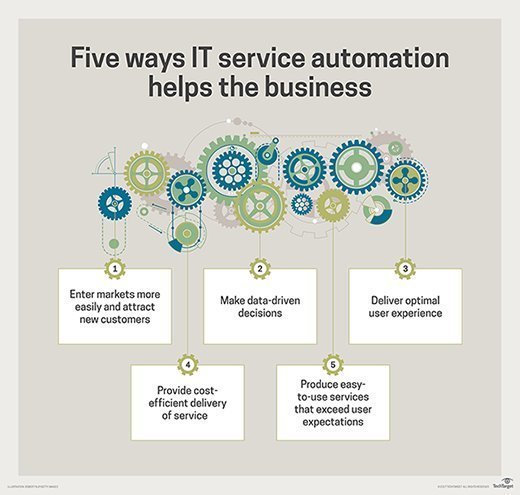
Syda Productions - stock.adobe.c
5 ways ITSM automation is driving business value
Current trends in ITSM automation include the adoption of intelligent automation, ITSM as a service, digital labor, artificial intelligence and machine learning.
CIOs and IT service providers are under constant pressure to deliver more business-aligned value through technology, best practices and staff. IT service management (ITSM), a framework for increasing productivity and performance, responding to requests, resolving incidents and reducing costs, can be improved by automating tasks in five ways: intelligent automation, ITSM as a service, digital labor, artificial intelligence and machine learning.
Intelligent automation
Organizations of all sizes can now easily deploy intelligent automation technology to enable the digitization of traditional service desks and infrastructure operations. Such transformations can largely be accomplished independent of legacy IT functions or outsourcing service providers. One way this type of ITSM automation happens is by utilizing the native functionalities of underpinning technology components, such as the Active Management Technology features of chipsets, that support automated ITSM task performance even if the hardware is in a powered-off state.
ITSM as a service
The rapid deployment capabilities, cost predictability and consumption-based features of an ITSM as a service delivery model allow an organization to aggregate the benefits of its own set of ITSM tools while avoiding the future-switching costs and barriers to effectiveness that are often inherent in on-premises ITSM proprietary tools. If ITSM's feature-rich core tools are deployed through the use of a cloud-based service provider, then an organization can operate more efficiently without incurring unintended incremental cost drivers and service risks.
ITSM automation via digital labor
Standardizing and automating high-volume, repeatable tasks that have historically been performed by human intervention is at the core of ITSM tools. Self-service portals, password reset, self-help and self-heal technologies are widely available and can be delivered effectively as a persona-driven web experience in coordination with intelligent automation device management, notifications, support, event/incident handling, request fulfillment, knowledge enhancement and informed problem management. When successfully executed, this type of ITSM automation can reduce the volume of tickets, and the corresponding need for service desk or operational support intervention, by 30% to 40% and provide significant cost savings to IT engineers, service providers and related operations departments.

Artificial intelligence
IT is increasingly leveraging AI to automate problem-solving processes across all IT layers, such as hardware, software, application and database. Through AI, IT analytics are proactively acted on, issues are responded to and appropriate actions are identified. The AI platform dramatically improves IT process responsiveness and effectiveness by: collecting, aggregating and establishing relationships; applying the know-how to respond; and acting in ways that amplify IT capabilities. By using artificial intelligence to automate repetitive and programmatic tasks, IT staff can instead channel their creativity, passion and imagination into tasks that provide greater value to the dynamic business environment, while also achieving an incremental savings of operational costs of 15% or more in the first year.
Machine learning
In today's evolving IT environments, the ability to respond to infrastructure failures, service degradations and impaired systems performance requires constant knowledge acquisition, synthesis and machine learning. In combination, intelligent automation, digital labor and AI form a critical foundation that enables robotic process automation (RPA) to leverage machine learning capabilities and deliver more than a 60% reduction in run/support costs over a multiyear term. For example, the merging of AI with RPA technologies creates machine learning-based outcomes that can be presented to end users through highly effective chatbot capabilities. The chatbot's natural language processing algorithms perform the lexical, syntactic and semantic analysis on the user-submitted questions or application alerts, responding to them in real time without needing to contact the service desk or operations support team. These services are available to instantly assist users with their needs by offering highly capable and continually improving configuration, fault and remediation services. When implemented effectively, a chatbot can redefine and provide an engaging experience to users.








